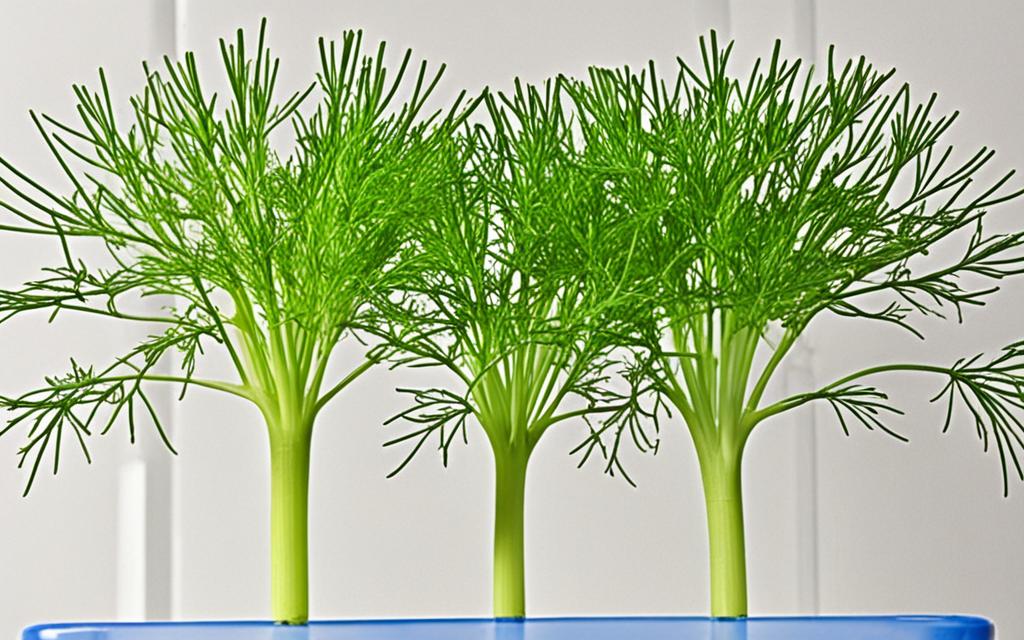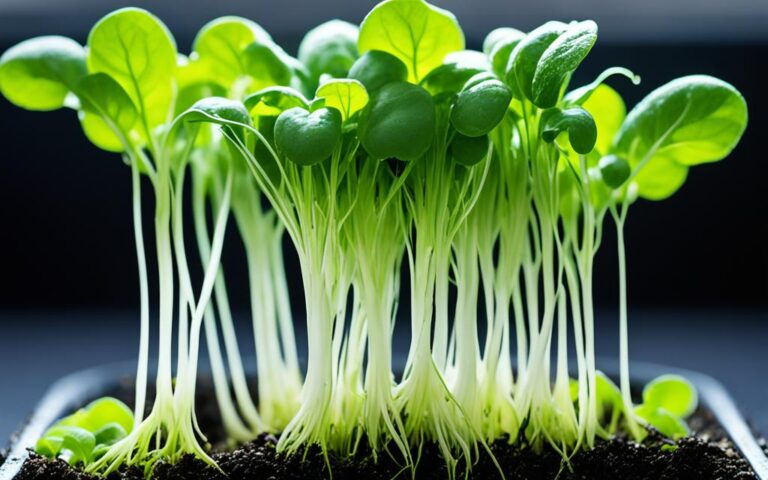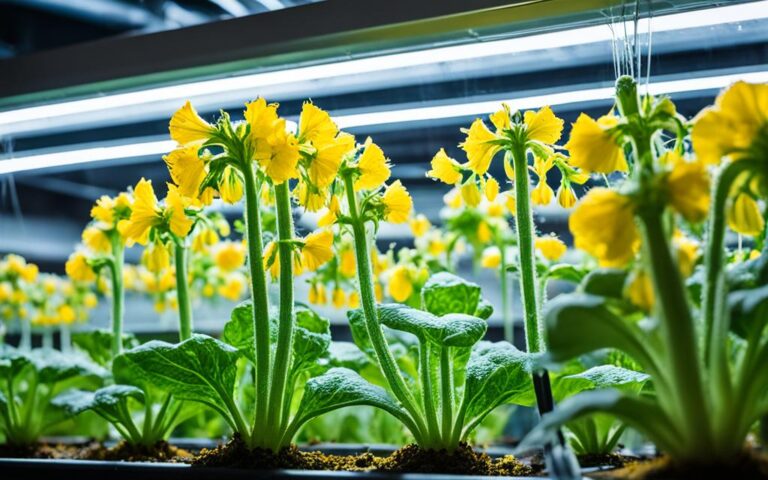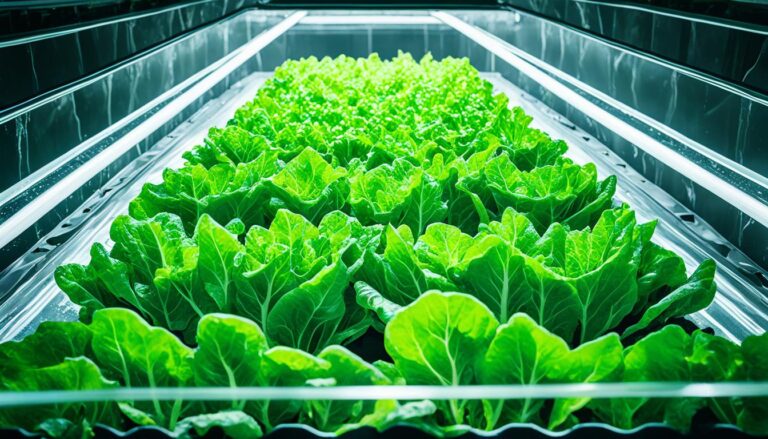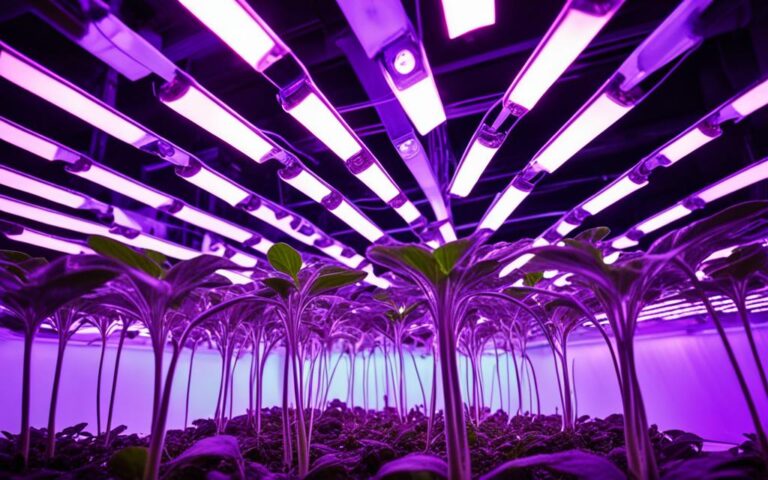Growing Hydroponic Fennel: Tips & Techniques
Did you know hydroponic fennel can produce up to 30% more than growing it in soil? This method is becoming popular with both home and commercial growers. It’s great for saving space and growing the versatile herb Foeniculum vulgare efficiently. This guide is perfect for anyone, whether you’re new to hydroponics or have years of gardening experience. It will give you all the tips and techniques to grow a lot of tasty hydroponic fennel.
Key Takeaways
- Hydroponic fennel can yield up to 30% more than traditional soil-based cultivation.
- Fennel has a rich history, with the ancient Greeks associating it with the Battle of Marathon.
- Hydroponic cultivation allows for efficient, space-saving production of this flavorful herb.
- This guide covers selecting the right varieties, setting up the ideal hydroponic system, and managing nutrients for a successful fennel harvest.
- Environmental conditions, such as light, temperature, and humidity, are crucial for optimal fennel growth in a hydroponic setup.
Introduction to Hydroponic Fennel
Fennel is a versatile herb with a long history. It started in the Mediterranean region. The ancient Greeks called it “marathon,” linking it to the famous Battle of Marathon.
Today, people love it for its mild, sweet taste, similar to licorice. It’s used in many dishes, from seasoning meats to garnishing them.
History and Origins of Fennel
Fennel has been around for centuries. It was first domesticated in the Mediterranean, where it thrived in the warm climate. Over time, it spread worldwide, becoming a key ingredient in many cuisines.
Benefits of Growing Fennel Hydroponically
- Efficient use of space: Hydroponic systems let fennel grow in a compact, controlled space, making the most of available space.
- Precise control over nutrients: Hydroponic systems let you carefully monitor and adjust nutrient levels for optimal growth and quality.
- Year-round production: Hydroponic fennel can be grown all year, no matter the outdoor weather.
- Consistent, high-quality crop: Hydroponic fennel often has better flavor, texture, and appearance than traditional varieties.
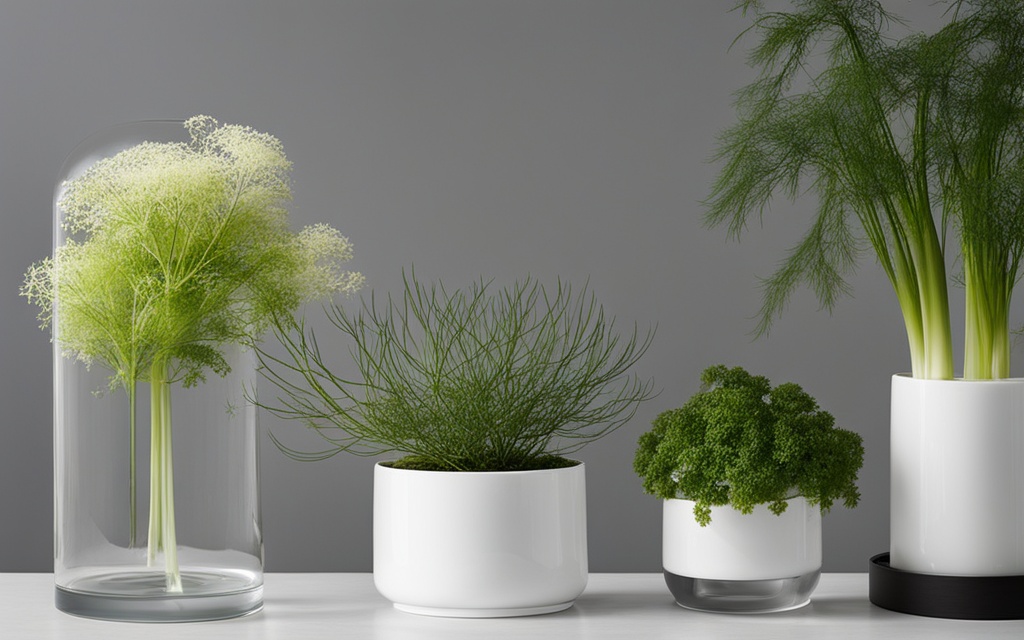
“Hydroponic farming has changed how we grow and enjoy fresh, flavorful fennel. It lets us produce this versatile herb all year, ensuring a steady supply and top quality.”
Growing fennel hydroponically has many benefits, making it popular for both commercial and home growers. By learning about its history and hydroponic benefits, you can explore new culinary possibilities with fennel.
Choosing the Right Fennel Variety
Choosing the right hydroponic fennel variety is key for great growth and yield. The Finocchio Fennel, Romanesco Fennel, and Dragon Fennel are top picks. They do well in soilless systems, giving good performance and tasty flavors.
Best Hydroponic Varieties for Fennel
- Finocchio Fennel: This variety grows into a compact bulb with a sweet, anise-like taste. It excels in hydroponics and is great for many recipes.
- Romanesco Fennel: It’s known for its unique, spiral fronds and strong, aromatic taste. Hydroponic growers love it for its looks and flavor.
- Dragon Fennel: This type is famous for fighting diseases and growing well in various hydroponic setups. Its strong flavor makes it useful for cooking and health remedies.
When picking the best fennel for hydroponics, think about yield, disease resistance, and demand. Choosing wisely ensures a steady and quality hydroponic fennel harvest.
Setting Up Your Hydroponic System
Setting up a hydroponic system for fennel is key to a great harvest. Fennel does well in many hydroponic setups, each with its own benefits. You can choose from a nutrient film technique (NFT), deep water culture (DWC), or a raft system. The main thing is to pick a system that fits your space, water needs, and fennel plant requirements.
Selecting the Ideal Hydroponic System for Fennel
Think about these factors when picking a hydroponic system for fennel:
- Space constraints: Figure out how much space you have and choose a system that fits well.
- Water and nutrient management: Check if you can keep the water and nutrients at the right levels for fennel.
- Fennel plant characteristics: Know what fennel needs, like its roots and how it grows, to pick the right system.
Essential Components for a Fennel Hydroponic Setup
No matter the system you pick, here are key parts for a thriving fennel hydroponic setup:
- Grow tray or channel: Gives a strong, controlled spot for the fennel plants to grow.
- Nutrient reservoir: Feeds the fennel plants with the right nutrients and water.
- Air pump and air stones: Keeps the nutrient solution oxygenated for healthy roots.
- Water pump and timer: Sends the nutrient solution to the plants at regular times, keeping conditions perfect.
By picking the right hydroponic system and getting the key parts, you can make the best space for your hydroponic fennel. This will help you get a big harvest.
Nutrient Management for Hydroponic Fennel
Getting the nutrients right is key for hydroponic fennel to grow well. Fennel needs a special mix of nutrients for healthy growth. Knowing what fennel hydroponic nutrient requirements are helps grow a strong crop.
Fennel likes a certain level of nutrients and a specific pH. It needs nitrogen, phosphorus, potassium, calcium, and magnesium, among others. Keeping an eye on the nutrient levels, pH, and electrical conductivity (EC) is important. This ensures the plant stays healthy and produces well.
Here are some tips for the best hydroponic fennel nutrients:
- Use a balanced nutrient solution made just for fennel.
- Check the EC and pH levels often and adjust them if needed.
- Make sure the nutrient solution reaches all parts of the plant.
- Add calcium and magnesium for strong cell walls and healthy plants.
- Change the nutrient levels based on the plant’s growth stage.
By following these hydroponic fennel nutrients tips, you can make the best environment for your fennel. This leads to a big and tasty harvest.
Environmental Conditions for Hydroponic Fennel
Cultivating hydroponic fennel needs knowing its environmental likes. Fennel grows well in a mild climate. It needs the right amount of light, temperature, and humidity.
Light Requirements for Fennel
Fennel loves the sun and needs at least 12 hours of sunlight daily. Whether from the sun or grow lights, the right light is key for its growth. Hydroponic fennel light exposure is vital for healthy growth, giving it lush foliage and big bulbs.
Temperature and Humidity Needs
Fennel grows best in temperatures between 60-70°F. It can handle heat and cold but not frost. Growers should keep it away from freezing temperatures to avoid damage or death. Keeping the fennel temperature requirements right is key for its health and productivity.
Fennel also needs humidity of 40-60%. The right fennel humidity needs prevent mold and disease. They also help with strong plant growth. Adjusting the humidity in the hydroponic system helps the fennel grow well.
Knowing the light, temperature, and humidity needs for hydroponic fennel helps growers create the best environment. This leads to lots of harvests and tasty, flavorful fennel.
Seed Germination and Transplanting
Fennel is easy to grow from seed, with germination rates between 60% to 90%. Soaking fennel seeds in water for 24 hours before planting helps with hydroponic fennel germination. This method softens the seed coat and speeds up germination.
It takes 10-14 days for the seeds to germinate. They are ready for transplanting fennel hydroponically in 3-5 weeks. When moving seedlings to the hydroponic system, handle the roots with care. Make sure to space the plants 30-45 cm apart for growth.
Preparing Fennel Seeds for Germination
- Soak fennel seeds in water for 24 hours to soften the seed coat and promote faster germination.
- Drain the seeds and pat them dry with a clean paper towel.
- Sow the pre-soaked seeds in your preferred growing medium, such as coco coir or rockwool cubes.
- Keep the growing medium moist but not waterlogged during the germination process.
Transplanting Fennel Seedlings into the Hydroponic System
When fennel seedlings are 3-5 weeks old and have strong roots, they’re ready for the hydroponic system. Handle the roots with care and space the plants 30-45 cm apart for growth.
| Step | Action |
|---|---|
| 1. Prepare the Hydroponic System | Ensure the hydroponic system is clean, the nutrient solution is at the correct pH and EC levels, and the growing environment is ready to receive the transplants. |
| 2. Transplant Seedlings | Gently remove the fennel seedlings from the growing medium, being careful not to disturb the roots. Plant them in the hydroponic system, spacing them 30-45 cm apart. |
| 3. Provide Support | If necessary, use plant clips or stakes to provide additional support for the fennel plants as they establish in the hydroponic system. |
“Proper seed preparation and gentle transplanting techniques are the keys to successful hydroponic fennel cultivation.”
Maintenance and Care
Keeping a hydroponic fennel crop healthy needs careful watching and early action. It’s key for growers to keep an eye on the pH and electrical conductivity (EC) of the nutrient solution. These levels are crucial for your fennel plants’ health and how well they grow.
Monitoring pH and EC Levels
Hydroponic fennel does best with a pH of 6.0 to 7.0 in the nutrient solution. Checking and adjusting the pH regularly makes sure the plants get the nutrients they need for strong growth. Also, keeping the EC levels between 1.0 and 1.4 ensures the right amount of nutrients, avoiding problems that could harm your hydroponic fennel maintenance.
Pruning and Training Techniques
Smart pruning and training can really boost your hydroponic fennel’s growth and taste. Cutting off flower buds helps the plants focus on making more leaves. Harvesting the outer leaves and leaving the inner ones lets the plant keep growing and makes it bushier and more productive.
“Proper fennel pruning and fennel training practices are essential for ensuring a thriving hydroponic fennel crop.”
By keeping an eye on fennel pH and fennel EC levels, and using smart pruning and training, you can keep your hydroponic fennel plants healthy and productive all season.
Pest and Disease Management
Fennel is a tough plant that doesn’t often get pests or diseases. But, hydroponic growers need to keep an eye on their plants for any problems. Knowing about common pests and diseases helps keep the harvest healthy and productive.
Common Pests Affecting Hydroponic Fennel
Aphids are a big problem for hydroponic fennel. These tiny insects can spread fast in a hydroponic setup, slowing down plant growth and harming leaves and stems. Luckily, you can fight aphids with helpful insects like ladybugs or lacewings, or by using organic bug sprays.
Preventing and Treating Diseases
Fennel is usually resistant to diseases, but hydroponic growers should watch out for root rot or powdery mildew. Keeping the growing conditions right, like the right nutrients, pH levels, and clean water, helps prevent diseases. Also, keeping the hydroponic setup clean by washing and disinfecting things regularly can lower the chance of getting sick plants.
If pests or diseases show up, it’s important to act fast. Talking to hydroponic experts or using trusted online guides can help figure out and fix problems quickly. This keeps the hydroponic fennel crop healthy and productive.
Harvesting Hydroponic Fennel
Harvesting your hydroponic fennel at the right time is key. Wait until the plants are 0.5 to 1 lb per bulb, usually 6-8 weeks after you planted them. This means the bulbs are firm and the leaves are bright green, showing they’re ready.
Signs of Maturity and Ideal Harvesting Time
Look for these signs to know when to pick your fennel:
- Bulb size and firmness: The bulbs should be firm and full-sized, around 3-4 inches in diameter.
- Leaf color: The fronds should still be a bright, healthy green, not yellowing or wilting.
- Plant height: Fennel plants should reach a height of 0.5 to 1 lb per bulb, typically 6-8 weeks after transplanting.
Consider a two-stage harvest to get the most from your fennel. Cut the leaves first for salads, then take the whole plant, including the bulb, a bit later. This way, you get to enjoy fennel in different ways while letting the bulb grow fully.
| Hydroponic Fennel Maturity Signs | Ideal Harvesting Time |
|---|---|
| Firm, full-sized bulbs (3-4 inches in diameter) | 6-8 weeks after transplanting |
| Vibrant green, healthy leaves | 6-8 weeks after transplanting |
| Plant height of 0.5 to 1 lb per bulb | 6-8 weeks after transplanting |
Keep an eye on the when to harvest hydroponic fennel and the hydroponic fennel maturity signs. This will help you get a great harvest of this versatile crop.
hydroponic Fennel Yield Optimization
Getting the most out of hydroponic fennel is key to indoor gardening success. By managing the system, nutrients, and environment well, growers can get lots of this tasty and useful herb.
In a good hydroponic setup, fennel can produce 5-8 pounds per ZipGrow Tower in an 8-week cycle. Important things that help get the most hydroponic fennel yield are:
- Keeping the right electrical conductivity (EC) and pH levels for nutrient uptake
- Providing enough light that meets fennel’s needs
- Using proper pruning and training for healthy growth and more produce
By keeping an eye on and managing these factors, growers can maximize hydroponic fennel production. This leads to a big harvest.
| Metric | Optimal Range |
|---|---|
| EC (Electrical Conductivity) | 1.2 – 1.8 mS/cm |
| pH | 6.0 – 6.5 |
| Light Intensity | 6,000 – 8,000 lux |
| Growing Cycle | 8 weeks |
| Yield per ZipGrow Tower | 5 – 8 lbs |
“Achieving optimal hydroponic fennel yield requires a balance of precise nutrient management, environmental control, and attentive cultivation practices.”
Using and Storing Hydroponic Fennel
Hydroponic fennel is a versatile ingredient that can be used in many dishes. It adds a unique licorice-like flavor to both savory and sweet dishes. This makes it a great addition to any kitchen.
Culinary Uses and Recipes
The bulbs of hydroponic fennel are tender and crunchy, similar to onions. They’re perfect for soups, stews, and roasted vegetables. The fronds are great as a fresh garnish for salads, pastas, and seafood.
You can also use fennel in baked goods like bread and pastries. It adds a special flavor to these treats.
Here are some delicious recipes to try with hydroponic fennel:
- Roasted Fennel and Beet Salad with Citrus Vinaigrette
- Fennel and Sausage Pasta Bake
- Caramelized Fennel and Apple Tartlets
Proper Storage Techniques
Proper storage is key to keeping your hydroponic fennel fresh. Store the bulbs and leaves separately. Wrap the leaves in a damp paper towel and keep them in the fridge for up to a week.
Store the bulbs in a sealed container or bag in the fridge for up to 10 days. This way, you can enjoy the entire plant and reduce waste.
By using the whole plant and storing it right, you can enjoy hydroponic fennel for longer. This makes it a versatile and flavorful addition to your meals.
Conclusion
Growing hydroponic fennel is a great way to have this tasty and healthy herb all year. By picking the best fennel hydroponics types and setting up the perfect hydroponic setup, you can get a steady, top-quality crop of growing fennel hydroponically. This guide has shown you how to grow hydroponic fennel from seed to harvest, including how to manage nutrients, control pests and diseases, and harvest at the best time.
Adding this versatile herb to your hydroponic setup can make your products more varied and give your customers a fresh, local, and eco-friendly choice. By getting good at hydroponic fennel growing, you can bring out the best in this tasty and healthy crop. This means you can offer your customers great quality and taste all year.
With the right knowledge and care, growing hydroponic fennel can be both rewarding and profitable. By using the tips and strategies from this article, you can start your journey to becoming a top fennel hydroponics grower. This will help you meet the growing demand for fresh, locally-grown produce.
